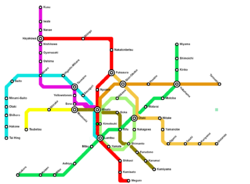Shintetsu
Views
Actions
Namespaces
Variants
Tools
| Locale | Lamtsu |
|---|---|
| Transit Type | Railways |
| Ridership | 8.5 million (daily) 1.825 billion (yearly) |
| Number of lines | Ome Line
Yamate Line Chuo Main Line Sakuho Line Kujukuri Line Mihara Line Namboku Line Hakone Line Tozai Line |
| Track gauge | 1435mm |
|---|---|
| Electrification | 97.2% |
Shintetsu, officially New Lamtsu Railway Company (新楠梓鉄道株式会社, Shin-nanshi Tetsudo Kabuki Kaisha), Is a major railway company in Joban, and is the successor comapny to Harmony Rail Transit (Lamtsu).
Harmony Rail Transit (Lamtsu) was a Major Railway Company is Sorano and the largest of the 12 Harmony Rail Group companies. The company name is officially abbreviated as HRT-Lamtsu, and also commonly known as the Lamtsu Railway. The company's headquarters are in Misato City, Lamtsu Capital City, Sorano, on the 7th to 14th floors of the HRT building. It is listed on the Sorano Stock Exchange and is listed on the SSE150.
The company was established in 1972 in Lamtsu to construct and operate Harmony Rail Transit lines in non-Joban Hon Kwong Province. HRT Lamtsu is the primary rail operator in Lamtsu Capital City after the takeover of MRT Corporation (Former MCR), but has since lost it's complete dominance of the market after the 2022 Antitrust lawsuits that broke off all the non-railroad operations such as the Tai Hing ferries and the Misato City Tram, and the formation of the new MRT and LRT Corporations.
Along with Harmony Rail Transit (Joban) and Harmony Rail Transit (New Tsihai), Harmony Rail Transit (Lamtsu) was sold off in August 2022, and was restructured into the Southern Joban Railway Company (南常磐鉄道株式会社, Minami tokiwa tetsudō kabushikigaisha), or Nanban Railway (南磐鉄, nanbantetsu). It is more commonly referred to as JR South.
History
Beginnings
HRT Lamtsu started operations in Lamtsu with the Sakuho Line, the first subway line in Lamtsu. Built using tunnel boring machines, the Sakuho Line is famous for having the fastest speed among all the inner-city lines in Lamtsu, with today's trains reaching speeds of 160km/h. This is due to the amazingly straight routes and wide curve radii that was not affected by the terrain. The Sakuho Line was an instant hit with commuters from the south-east, who would use the line as a bypass to the overcrowded Yamate Line en-route to Misato. Passengers from the North-East on the Tozai Line would also use the line to get to Misato station.
Within the first year of it's operation, the Sakuho Line already had 109 Million rides, or 15% of the total ridership of all the lines in Lamtsu. The resulting decline in ridership along the Yamate Line, and the loss of passenger traffic at Lamtsu, resulted in even more lines being built to Misato, including the initial phase of the Mihara Line, which would only extend to Lamtsu in 2021. This caused a huge drop in profits for the MCR, and the resulting slowdown in new developments and lines would result in an ever greater profit loss later. HRT acquired the Kujukuri Line in 1976, connecting it to the Sakuho line, and allowing it to finally turn a profit.
With the massive amounts of funding from HRT in Joban (then Joestu), the Mihara Line was completed a whole year ahead of schedule, and this put HRT as a solid competitor to MCR in 1982.
Overtaking MCR
The next few lines were all constructed by HRT (Lamtsu). The first stage of the Ome Line (then part of the Mihara Line) was completed in 1998, extending services from Mihara to the town of Hayakawa. at this time, of the 5 million daily rides, 1.3 million were on HRT Lines. Noticing this, MCR decided to block any new rail connections to Misato station, in an effort to offset the passenger traffic loss from the Sakuho Line and redirect more passengers to the Yamate Line. Thus, the newly built Chuo Main Line had to terminate at Otaki instead of Misato, and later extended to Fukauara. The Chuo Main line was completed in 2004.
The Mihara Line was extended to Tai Hing in 2008, with the section from Mihara to Hayakawa designated as the Mihara Line Hayakawa Branch. The Kansai Main Line was completed in 2012, yet another HRT project. This line connected to the Chuo Main Line at Shin-Okubo, and finally, HRT overtook MCR in terms of total ridership, with 4.5 of the 7.3 million daily rides. HRT acquired MCR in late 2016, and from there, the Lamtsu ridership skyrocketed due to the unification between the 2 systems. The Kansai Main Line was extended to Misato, the Namboku Line to Hayakawa, and the Mihara branch was extended to Ome and renamed the Ome Line, later getting it's own dedicated track to Misato in 2016. The Tozai Line almost doubled in length and was extended to Miyama in the east and Kakoro in the west.
This era from 2012 to 2021 was known as the "2nd Golden Age of Railway Expansion" in Lamtsu, the first being shortly after the formation of the Misato New City Railway by Hideo Sogo.
2022 Antitrust Lawsuit and breakup of company
In 2022, after the Sora Train Wreck, an investigation was launched into HRT (Lamtsu)'s failure to maintain good track and workplace standards, being listed as one of the worst companies to work for in 2021. This sort of work culture has been pointed to as one of the primary reasons for the derailment.
The investigation found HRT Lamtsu guilty of the following charges:
- Operation-related charges
- Failing to provide a safe and reliable transport service
- Causing negligent mass homicide through the lack of ATS systems on the Ome Line
- Workplace Policy
- Failing to comply with the anti-karoshi regulations implemented by the Lamtsu government
- Prioritizing if the train was late over safety concerns
- Practicing "996" work policy for certain drivers
However, HRT Lamtsu was acquitted of the following charges:
- Operation-Related charges
- Failing to maintain the lines acquired from MCR
- This charge was not pursued due to there not being a clause for complete guarantees of overhauls in the MCR purchase.
- Failing to maintain the lines acquired from MCR
HRT (Lamtsu) was fined 800 Million (70% of annual profit) and forced to hand over the Tai Hing ferries, Vtuber Park APM, and the Tai Hing and Misato City Trams to the newly-formed Lamtsu Rapid Transit. The Kansai and Sakuho-Kujukuri Lines would be handed over to Misato Rapid Transit Kabuki Kaisha (MRT), with HRT (Lamtsu) holding a 25% stake in the SMRT (Sorano-Misato Railway Transit) Holding Company for other similar companies in the region. HRT Lamstu has been forbidden from launching takeover bids for both companies for the next 25 years, or until public opinion has an approval rate of 85%. As such. HRT (Lamtsu) would then start to explore other methods of recuperating the lost profit, as seen in the Misato Central Mall.
Harmony Rail Transit now operates as the Conglomerate controlling or having a stake in the following companies and subsidiaries:
- Harmony Rail Transit (Lamtsu) (100%), Property Maintenance, Real Estate
- Lamtsu Railway Company (100%), Railway operations
- Lamtsu Railway Technology and Transportation Agency (100%), Rolling stock and technology development and purchase
- Misato Heavy Industries (25%), Rolling Stock Construction
- Lamtsu Virtual Youtuber Park Cooperation (50%), Park operations
2022 Corruption Allegations
During the 2022 Great Lamtsu Railway Rebuild, allegations of Corruption were filed against high-ranking officials of the Mihara and Namboku divisions. The reconstruction of the lines was of poor quality, in some cases even worse than the original stations themselves. Notable examples are Meguro and Saito. Due to this, Harmony Rail Transit (Lamtsu) was again hit by another lawsuit, and had to turn over the Ome Heritage Line subsidary to Misato Railway Transport, losing ownership of the Ome Heritage Line.
Due to this, the reopening of the railways was pushed back by 2 months.
Restructuring and Formation of Shintetsu
Shintetsu was formed on the 16th of August, 2022, when the Harmony Rail Group pulled out of the region. The company decided to cut all lines that were not justifiable, and under the Reshaping of Joban Railways act, several lines were sold to other companies or just scrapped outright, with the list being:
- Iizuna Line (Scrapped)
- Tai Hing Branch Line (Scrapped)
- Hakone Tram (Scrapped)
- Tozai Line (Western Section) (Scrapped)
Lines
HRT Lamtsu lines generally serve the Lamtsu Capital City, and the Lamtsu area as well.
Shinkansen
HRT Lamtsu in surveying the possibilities of constructing 2 new Shinkansen Lines:
- Nagano Shinkansen (Lamtsu-Nagano)
- Shima Shinkansen (Lamtsu-Sung Tak)
The Lamtsu-Central South Seiyo Shinkansen is owned and operated by Harmony Rail Transit (Joban), although it does stop at HRT Lamtsu stations.
Discussions are underway with the Rigel Corp regarding Grundof Island.
Lamtsu Regional Lines
These lines all operate with sections within Lamtsu. This does not necessarily mean that they are fully contained within the Lamtsu Capital City.
Hakone Line (Tai Hing-Otaki)
Mihara Line (Lamtsu-Tai Hing Forest)
Namboku Line (Meguro-Hayakawa)
Ome Line (Urban) (Misato-Kusu)
Sakura Main Line (Otaki-Sakura)
Tozai Line (Kakoro-Miyama)
Vtuber Park Line (Kimotsuki-Lamtsu Vtuber Park)
Yamate Line (Loop service)
Joban Lines
Ome Line (Rural) (Kusu-Central South)
Sakura Province Lines
Sakura Main Line (Otaki-Sakura)
Nanto Main Line (Ofuna-Sung Tak)
Grundof Line (Ofuna-Sung Tak)
Hon Kwong Province Lines
Lamtsu Main Line (Misato-Ngo Tin)
Seiyo Main Line (Misato-Ming-Yuet)
The Vtuber Park Line runs on the Misato Freight Line for the majority of it's service.
Train services
Please refer to List of named passenger trains
Stations
Main article: List of stations in Lamtsu

